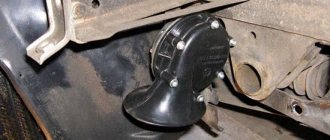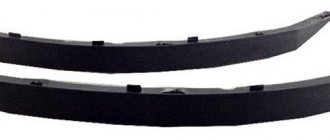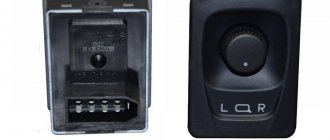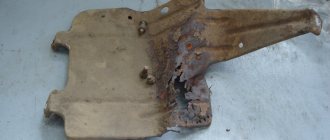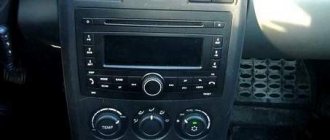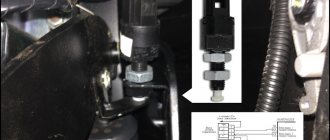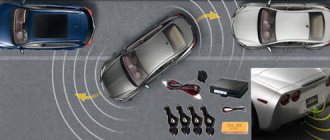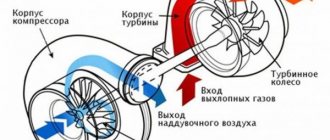01 December 2016 Lada.Online 83 746 7
All cars have a device for producing sound signals (horn), but its sound does not always suit the owner. This is the main reason for replacing the standard horn with alternative options (for example, with a sound signal from the Volga). Let's look at this improvement in detail.
Nowadays, horns are usually used in pairs. One with a high tone, the other with a low tone. This provides strength and beauty of sound.
Will need to buy:
- A couple of sound signals from GAZ 3110 (article number for high tone - 22.3721, for low tone - 221.3721), or an analogue, approximate price 500 rubles; Other sounds in this category.
- 4-pin relay 75.3777-10;
- Relay socket;
- Mounted fuse 10-15A;
- Single-core wire;
- Corrugation for wires;
- Terminals;
- Brackets/brackets for mounting sound signals (optional).
Installation and connection of a sound signal from the Volga is shown using the example of the Lada Vesta sedan. On other cars (for example, Lada Largus, Granta, Kalina, Priora, Niva 2121 or XRAY) all actions are performed in a similar way.
How to install a Volgov signal on a Priora
I decided to install 2 Volgov signals. But on the drive I saw enough that it is necessary to install relays and fuses, but I don’t understand at all why this relay is needed if we take the plus from the standard chip? I’m not good at electrical, but looking at the diagrams, I don’t plug it in at all...after all, there is a standard relay K8 for the signal and the signal fuse F5 also takes power from the battery. The factory signal requires 5-6A, and the Volgov signals 14A. Why can’t you just replace the F5 fuse from 10A to 15A or 20A (to give full power to the volgosignals) and take the plus for the signals from the standard chip and that’s it? Here is a diagram of the standard installation:
FakeHeader
Comments 50
You can install one set without a relay and not worry, but if you install 2 sets or more, then you cannot do without a more powerful (than standard) relay. I have 2 sets of Volgov horns, for them I took a separate + from the battery and through a relay.
I’ve been driving with Volgov signals for seven years, everything works fine, I connected it without any modifications, I took the car from new, I didn’t even bother whether there was a relay there or not, I signal often.
I installed Volga signals on the Priora, without a relay, without replacing the standard fuse. This is not the first car I have changed the signal. Nothing ever burned down anywhere. I use the signal, but I didn’t go to a wedding while driving.
don't get carried away! I installed it without a relay and I’m happy, everything is fine. and I like to honk at all sorts of woodpeckers)
How to install a Volga signal
Remove the front bumper (instructions for XRAY, Vesta, Grant, Priora, Kalina, Largus). If it was decided not to remove the standard sound signal (if necessary, you can return to the initial version), then we are looking for a suitable place to install signals from the Volga. Most often they are placed on the front bumper amplifier (on standard mounting bolts), behind the radiator grille or under the headlights on brackets.
Replacing the standard sound signal in case of breakdown
First you need to prepare the car for work by putting the parking brake on and turning off the ignition. Then you need to lift the hood and, armed with a “10” key, disconnect the negative terminal from the battery. Then you should dismantle the front bumper, which is best done with an assistant, so as not to damage the paintwork on the bumper itself and on the wings of Vesta.
Once this is completed, all that remains is to disconnect the plug with the wires from the signal horn. Then you can dismantle the signal itself, the bracket of which is attached to the body with one nut. For dismantling you will need an extension, a wrench and a 13mm socket.
Assembly is carried out in the reverse order - you need to secure the signal, inspect its operation, install the bumper with an assistant and tighten the terminal on the Vesta battery.
How to choose
Having decided to replace a relay or fuse in a Priora, take full responsibility for their selection and purchase. Under no circumstances should you buy cheap parts of unknown quality and origin.
It is better to give preference to original products produced by VAZ. As a last resort, buy relays or fuses from one of the well-known companies, such as Bosh, Hella or Tesla.
Replacing the sound signal on a Lada Vesta is a simple procedure that any owner should be able to perform. After all, driving without a properly working horn is a priori unsafe, and taking a car to a service station due to such a breakdown is an unreasonably large amount of time. However, replacement in the event of a malfunction is not the only need. Many people are simply not satisfied with the volume or tone of the sound signal, and they replace the standard Vesta components with alternative ones. Therefore, both of these paths need to be considered in more detail.
Fuse box Lada Vesta in the engine compartment
Fuse diagram:
| Fuse number (current, A) | Fuse color | Protected electrical circuit |
| F60 (70 A) | Pink | Electric power steering (EPS) |
| F61 (30 A) | Green | Rear window defroster |
| F62 (40 A) | Orange | Stability Program (ESP) Controller |
| F63 (15 A) | Blue | Air conditioner |
| F64 (5 A) | Light brown | Not used |
| F65 (25 A) | White | Stability Program (ESP) Controller |
| F66 (5 A) | Light brown | Automatic transmission (AMT) |
| F67 (-) | — | Not used |
| F68 (70 A) | Pink | Automatic transmission (AMT) |
| F69 (15 A) | Blue | Air conditioner |
| F70 (60 A) | Blue | Power supply circuits for fuses F4, 6, 7, 8, 12, 13, 14, 23, 26, 29, 31, 36, 37, 38, 42, 43, 44, 45, 47, 48, 49, 50 of the mounting block in the passenger compartment |
| F71 (60 A) | Blue | Generator |
| F72 (60 A) | Blue | |
| F73 (10 A) | Red | Sound signal |
| F74 (5 A) | Light brown | Reversing light switch |
| F75 (60 A) | Blue | Heated windshield |
| F76 (10 A) | Red | Anti-theft alarm |
| F77 (-) | — | Not used |
| F78 (7.5 A) | Brown | Canister purge valves, engine management system sensors (oxygen sensors, timing valve) |
| F79 (40 A) | Orange | Engine cooling fan |
| F80 (5 A) | Light brown | Heated windshield |
| F81 (-) | Blue | Not used |
| F82 (-) | Blue | Not used |
In a variant:
Relay diagram:
| Relay number (current, A) | Relay name |
| K21 (30A) | Heated windshield relay 1 |
| K22 (30A) | Heated windshield relay 2 |
| K23 (30A) | Starter relay |
| K24 (20A) | Horn relay |
| K25 (20A) | Alarm horn relay |
| K26 (-) | Not used |
| K27 (20A) | ECM main relay |
| K28 (20A) | A/C compressor clutch relay |
In a variant:
Recommendations
Comments 50
You can install one set without a relay and not worry, but if you install 2 sets or more, then you cannot do without a more powerful (than standard) relay. I have 2 sets of Volgov horns, for them I took a separate + from the battery and through a relay.
I’ve been driving with Volgov signals for seven years, everything works fine, I connected it without any modifications, I took the car from new, I didn’t even bother whether there was a relay there or not, I signal often.
I installed Volga signals on the Priora, without a relay, without replacing the standard fuse. This is not the first car I have changed the signal. Nothing ever burned down anywhere. I use the signal, but I didn’t go to a wedding while driving.
don't get carried away! I installed it without a relay and I’m happy, everything is fine. and I like to honk at all sorts of woodpeckers)
I’ve been driving with Volga signals for 4 years without additional relays and everything is fine! At a friend’s wedding, he honked a lot because the rest of the cars had factory beeps)))))
install a relay and that’s it... the chip itself will be a control plus for you, they’ve already given you the circuit... do it right.
I don’t know what’s wrong with the signal and what’s connected with it, I just want to screw your brains with what you wrote. The fuse that you wanted to change to a larger one is needed not by the signal, but by the wiring, like any other, that is, if you increase it and load the wire, it will melt and then light up, and the oversized fuse will not even light up unless it is shorted to ground... this It’s a mistake of many people and you have to remember that fuses, circuit breakers at home, are installed for adjustment, not for devices... regarding the relay, just take it out and it says on it how many amperes can be loaded on it, it’s simple. and by the cross-section of the wire you can determine the maximum current for it and you will understand what is the maximum for wiring in this case, you can install a fuse, download the sign on the Internet for yourself))
Thank you) Yes, I already realized that I was stupid)) I’ll install an additional relay)
I don’t know what’s wrong with the signal and what’s connected with it, I just want to screw your brains with what you wrote. The fuse that you wanted to change to a larger one is needed not by the signal, but by the wiring, like any other, that is, if you increase it and load the wire, it will melt and then light up, and the oversized fuse will not even light up unless it is shorted to ground... this It’s a mistake of many people and you have to remember that fuses, circuit breakers at home, are installed for adjustment, not for devices... regarding the relay, just take it out and it says on it how many amperes can be loaded on it, it’s simple. and by the cross-section of the wire you can determine the maximum current for it and you will understand what is the maximum for wiring in this case, you can install a fuse, download the sign on the Internet for yourself))
... well, I’ve been driving with Volgov for 8 years without special extras and everything is fine. and apparently I’m not alone. in my opinion, these are the pens of “experts”
And no one is forcing anyone to install a relay, people are just trying to point out the truth :) Do you know how reliability is calculated for products for the defense industry? (I think you can hardly imagine) For example: all power circuits (over 10A) are duplicated by a second wire = ) one of the examples of reliability... It’s bad that we have such a mentality... Everything is “Russian at random” And the chimney with the hood is at random... And these are not “the pens of experts”, you can’t fool physics... there are a lot of people like this: “My life my rules”...
I think comparing the requirements for defense equipment and the beeps on the Priora... this is kind of extreme. It’s not just maybe, but it works. long and hard. When I installed the amplifier on speakers and a sub, I calculated the cross-section of the wire and the fuse. when I made the box for the subwoofer, everything was also taken into account and done “measure seven times - cut once.” Rationality is needed in everything IMHO. and putting duplicate wires on everything... it's overkill.
Well, no one talks about redundancy) here they say it correctly... You can’t fool physics. Note that I wasn’t the only one who said about the need for installation... it means there’s something in it
everyone decides for themselves what and how to do. I have my own experience. I’m writing about him. The theory is difficult - I’m not a physicist (but an economist)
I didn’t install anything, no additional relay, no additional fuse, everything is standard. Everything works, everything beeps. Details in the blog.
I don’t know about Prior, but in 10 families, when connecting Volga signals without pressing the signal button, they immediately start yelling, since the control wire is the mass of the car. And Volga signals, on the contrary, + is the manager. So in our case we install an additional relay. And this way we simply correct the situation. The first time I plugged in the Volga signals myself and they started yelling. I had to install a relay. Well, I think it was possible to change places in the steering wheel itself. Noya did not do this.
I didn’t bother with the relays and the signals in general, I just installed the Volgo signal and that’s it, it never burned out. My only mistake was that I installed the signals on the lower grille of the bumper (water, snow, etc. clog the signals)
I took the plus with the battery; for this you need an additional relay. And I hung an additional relay on the standard wiring.
Install it and don’t worry, I understand if you’re throwing weddings then you need a relay, otherwise a one-time pipe won’t do anything, my opinion
For a year now everything has been working smoothly through the original relays and fuses.
If something short-circuits in the signals, the wiring will float!
Fuses protect against this.
The standard wire will start to melt faster than the 15-20A fuse you installed.
Who installed this fuse? The regular one is worth it!
Is the standard one enough for a 14A load? With a short press it is possible. If it lasts for a long time it will fly out
Enough. Time it? )
What I’m saying is that if you compare the operating parameters of Volga signals with the cross-section of the original wire and protection, it becomes clear that the original wire and protection are not designed for this load. Working to the limit
I'll check it out anyway. I'm already interested.
What I’m saying is that if you compare the operating parameters of Volga signals with the cross-section of the original wire and protection, it becomes clear that the original wire and protection are not designed for this load. Working to the limit
Relay and fuse blocks
The VAZ-2170 has three relay and fuse blocks:
- main block;
- mounting block;
- additional mounting block.
Luxury "Priors" with air conditioning have another additional block in which relays and fuses are located that are responsible for the operation of climate control equipment.
Main power fuse block
The main unit is located in the engine compartment of the car next to the battery and expansion tank. It is protected from above by a removable plastic casing. The main unit contains only six fuses that are responsible for the operation of the main (power) electrical circuits of the car.
To replace the fuses in the main unit, you need to disconnect the ground on the battery, remove the cover and replace the faulty part. VAZ-2170 mounting block
Relays and fuses in the cabin
The mounting block is located in the car interior under the dashboard on its left side. It is protected by a removable plastic panel attached to the “torpedo” using three latches. To remove the panel you need to turn each of these latches 900 degrees. After this, the panel will be completely removed.
The location, number, and markings of relays and fuses in the Priora mounting blocks may differ depending on the type of vehicle equipment.
Mounting block fuses
To remove the mounting block from its seat, you only need a screwdriver with a Phillips bit. She needs to unscrew the screw securing the block, then, pulling it towards you, disengage it from the fastening hooks.
Before replacing relays and fuses, you must disconnect the negative terminal from the battery. To remove the main unit, you will need to disconnect all terminals with wires connected to it, having previously marked their location.
Additional mounting block
The additional VAZ-2170 mounting block is located behind the panel of the right tunnel trim on the left leg side of the front passenger. To get to it, you need to unscrew the screws securing the cladding and remove it.
The additional mounting block contains three fuses and two relays.
To replace fuses and relays in the additional unit, there is no need to remove it from its mounting location. To remove the relay, you should unscrew the corresponding nut securing it with an “8” wrench. Before carrying out work to replace the relay, fuses or the entire unit, it is strongly recommended to disconnect the ground wire from the battery, and also disconnect the wiring harness block of the electronic engine controller from the additional connector mounting block.
Control and protection unit for climate control devices
In “Priors” equipped with climate control equipment, another additional mounting block is installed. It is located next to the main unit, and is attached to the “glass” of the left rack. Depending on the manufacturer of the climate system, the relays and fuses in it may have different locations and purposes.
As for the cost of relays and fuses, we can say that these elements of electrical equipment, if they need to be replaced, will not greatly affect your budget. Fuses, for example, cost from 5 to 60 rubles, depending on the type and rated current. The cost of the relay ranges from 50 to 200 rubles .
Lada Priora Hatchback “Priorka” › Logbook › Long ago and banal: signals from the Volga.
. In the second month after buying the car. Ideally, each signal should be attached to a strip of springy steel, then it will be even louder. But there is not much space in front of the radiator. Initially, I didn’t want to place signals, as many do, on the right and left behind the bumper, on the right and left of the side members. It is not right. Sound waves should have no obstacles in their path.
I installed Volgov ones. I had to slightly file the plastic of the horns on the side of the A/C radiator, otherwise they were very close. All power wires are 4mm2 (four squares) and of minimum length, laid in corrugations. Soldering everywhere, no crimping. A wire with a closed adapter for a 20A blade fuse comes from the positive terminal of the battery. I used closed terminals (in housings) and filled them with graphite (or Litol, I don’t remember) to reduce oxidation.
I also coated the signal studs and nuts generously with graphite.
Additional relay on the washer reservoir mounting stud. Directly from the stud, I took the ground through the terminal for the relay winding (pin 85). The 86th contact of the relay was connected with a wire to the standard signal connector.
Closed adapter for a 20A blade fuse near the positive terminal of the battery (hid behind the battery):
So these signals worked for almost 7 years. In the winter of 2017-2018, one tone began to fail, and then stopped working altogether. And a year ago I replaced them with a new set.
6 years ago signals from the Volga were installed. Original (Lyskovo). I took them off my broken 9 before selling it (probably a bad omen in vain. The Priora was beaten many times later...). So these signals are from 2010.
At the end of last year they started to glitch. And the signal volume was no longer the same. At the beginning of January of this year, one signal simply failed (high tone) and subsequently worked spontaneously.
Alternative options
In this case, the possibilities are limited solely by the imagination of the Vesta owner. Most often, sound signals from the Volga are installed on the Lada, since their sound is much louder. But there are other ways. The most common options for such “modernization” are:
- installation of signals from the Volga - in this case, different installation methods are possible (with connecting a relay in the cabin or under the hood)
— installation of other signals;
— installation of a signal with an integrated compressor;
— a combination of signal and high beam.
Installation of signals from Volga
It involves not only installing “shells” directly on Vesta, but also various options for connecting them. It is worth remembering that the sound signal from the Volga can be either old or new. However, they have no differences, except for a slight difference in tonality:
— sound signals Volga-3110 (22.3721/221.3721) – low and high tone;
- sound signals Volga, RAF S302/303D - low and high tone.
Sound pressure – 105-118 dB.
It is necessary to take into account that simply replacing the signals on Vesta will not work, because their current consumption is different. For Vesta this figure is 5A (passport data), although in reality it usually does not exceed 3.5A. Signals from the Volga consume 8A each, which gives a total of 16A. Therefore, for their installation it is necessary to use a 4-pin type relay. In particular, you can use relay 904.3747-10.
In addition, on Vesta, only one plug is supplied to the factory signal - “Plus” is permanent, since it supplies power to the fan, and “Minus” comes from the button on the steering wheel. Regarding the Volga signals, they only need “Plus”, because “Minus” goes directly through the metal mount to the body.
It is also necessary to take into account the dimensions of the sound signals - the Volgov ones are larger than the standard ones on Vesta. Therefore, installation in factory locations is excluded. In addition, it is not advisable to mount them directly to the body, as this will lead to vibration, and the sound of resonating metal will be mixed with the horn. So the best solution would be to use a bracket. The advantage of this option is its low cost - a set of “Volgov” signals will cost about 1,000 rubles.
Installation of relays in the interior of Lada Vesta
This is done directly in the fuse box. To carry out the work you will need the following components:
— sound signals from the Volga;
— 4-pin type relay;
— terminals – wide (6 units) and narrow (1 unit).
For installation, it is best to use the free space in the fuse box, to which the wires from the contact relay, which is responsible for activating the signal on the steering wheel, are transferred. In the place that has become vacant, a wire from relay contact “87” is placed. Next, you will need to remove the wire from the 13th contact block and insert it into the 13th connector “87” of the relay contact.
To supply “Plus”, you will need to feed the wire to relay contact “30” from connector “Ш5-6”, using a jumper of contact “86”. In this case, you will have to insulate the wire in red-white or black-white color, since “Plus” always goes to it.
This method has a number of advantages:
— location of wiring under the hood;
— installation of the relay in the appropriate block, which guarantees dryness;
— use of a separate “Plus”.
However, if you have a complete lack of experience and knowledge in the field of car electrics, it is better to contact an auto electrician when installing a relay in the cabin.
Installation of a relay under the hood of Lada Vesta
Regarding the components, they are similar, but the list will need to be supplemented with a few more elements:
— pendant type fuse;
- plastic corrugation - 2 meters.
The installation of the beeps themselves is carried out in a convenient place, and the connection is made according to one of two schemes:
- Using “Plus” directly from the fuse block;
- Using “Plus” directly from the battery, using a separate fuse.
In general, the second option is preferable. The relay should be located in a place protected from moisture. In addition, it is recommended to first wrap this component in polyethylene or insulate it.
The work is quite simple - you will need to dismantle the Vesta bumper and remove the factory signal, and then you can begin assembly. First, it is necessary to properly insulate the wires, and it is recommended to pass the wire that connects the signals through the corrugation so that it does not fray over time. Then you will need to fix the relay, after which you can put everything back together.
Combined option
This method involves retaining the standard Vesta beeps, but installing “Volgov” ones as additional ones. At the same time, combining 2 different tonalities will be a very original and specific move. Fixation is carried out in the same way as in previous cases, in any convenient place through a bracket. After which you will need to properly insulate all connections so that dirt and moisture do not get on them.
Installation of other sound signals on Lada Vesta
It is not necessary to concentrate exclusively on “Volgov” signals, since you can use beeps from other manufacturers. There are a lot of options on the market from different brands that you can buy - MITSUBA HOS-04GL, Elephant CA-10100 12v, GMP France / 410-510Hz and others.
Maintenance and testing of the VAZ generator
Generator Maintenance
- in cleaning external surfaces.
- in checking the fastenings of the generator to the engine.
- in checking the reliability of wire connections with the generator and voltage regulator
- in checking the tension of the generator drive belt (if the tension is weak, the generator will operate unstably; if it is strong, the belt and bearings will wear out quickly). The check should be carried out every 10 thousand km. mileage
- in checking the condition of the generator belt (there should be no cracks or delaminations on it).
- in checking the condition of the generator bearings (remove the belt and rotate the generator rotor by hand; if jamming, play, noise or clicks are observed, the bearings should be replaced).
How to connect the Volga signal
Standard sound signals of LADA cars consume no more than 5A, and Volga horns consume 7A each. In this regard, to connect them it is necessary to use a 4-pin relay. The Volga signal connection diagram is universal for all cars:
Before starting work, it is recommended to disconnect the negative terminal from the battery. All wires are laid in corrugation. We place the relay in a place protected from moisture and dirt. The whole process is also shown in the video:
About the guarantee. If you independently modify the car in terms of electrical components, there is a possibility of refusing warranty service for the car. Therefore, the installation of signals from Volga should be carried out at a service center, where after connection they will be ready to provide a document confirming the quality of work. You can also contact an authorized dealer for such modifications.
Are you satisfied with the operation of the standard sound signal on the LADA model? Are you ready to install a Volga horn? Let us remind you that we previously looked at other methods that can make operating a car more comfortable. For example, installing a gas tank cap bracket or how to make a flip-flop ignition key.
How to replace the sound signal on a VAZ 2170-VAZ 2172?
1. First, disconnect the block of wires from it, as shown in the large photo (Only in the large photo the block is removed and one terminal is left, but yours will be slightly different), then unscrew the nut that secures the bracket coming from the sound signal and remove everything this is assembled, by the way, when the block is disconnected, look at its contacts as well as at the terminal where this block is connected, they should be clean and free of signs of corrosion and oxidation, if necessary, clean it all with fine-grained sandpaper and try to reconnect the wiring block into its place and press the sound signal; if nothing changes, then the signal must be adjusted.
2. To adjust the signal, you need to hold it in a vice (by the bracket coming from it) or secure it anywhere, take two wires with the ends exposed and draw the plus from the battery to the plus of the sound signal, and the minus from the battery to the minus of the sound signal signal as shown in photo 1, the signal should start working, take a screwdriver, slowly turn the adjusting screw, make sure that the signal works loudly and clearly (see photo 2), if necessary, replace the sound signal with a new one.
Note! If you have some other signal installed and you don’t know where the minus is on it and where the plus is, in this case, use a special screwdriver with which you can find where the plus is, it works according to the following principle, put the terminal back on the battery (If it was previously reset) and when the screwdriver is brought to the terminals of the connector, when it lights up, this will indicate that this terminal goes to the plus, check the block of wires that comes from the sound signal and you will immediately understand where the plus is and where the minus is!
3. A new signal is installed in the reverse order of removal, when it is secured, a block of wires is connected to it and it is then checked for functionality; if the signal for some reason does not work, then perhaps the problem is not in it but in the wiring.
Additional video: How to get to the signal and how to remove it is shown in detail in the video below; in addition, it also shows the process of installing four signals from the Volga, which will be useful for absolutely any car.
How to install a Volga signal
Remove the front bumper (instructions for XRAY, Vesta, Grant, Priora, Kalina, Largus). If it was decided not to remove the standard sound signal (if necessary, you can return to the initial version), then we are looking for a suitable place to install signals from the Volga. Most often they are placed on the front bumper amplifier (on standard mounting bolts), behind the radiator grille or under the headlights on brackets.
Installing a horn from the Volga on a Priora
Volgov signals on the Priora in the regular place of LADA PRIORA for project #3 More details
Installation of sound signals from Volga (GAZ) on VAZ 2110, 2112, 2111 Read more
four signals from Volga to Priora (installation, full version) More details
VERY LOUD AIR SIGNAL ON THE LADA PRIOR. We turn the Priora into a locomotive. More details
How to CONNECT the Volgov signal Read more
Installation of Volga signals on the prior2 Read more
They set the horn from the Volga and jammed the brakes! Vis 2349. Lada Granta #6 More details
(easy and fast) Volgov Signals on VAZ 2107 Read more
LADA PRIORA Improved tuning of the sound signal More details
Replacing the standard signal. Replacing the horn with "Volga" Read more
Installation of a signal from the Volga Read more
Automotive relay. How does it work? What is it for? How to connect? More details
Correct installation of abnormal sound signals Read more
Powerful signal, instead of the standard one Read more
Powerful sound signal on a car Read more
VERY LOUD SIGNAL for 1000r/CHEAP flavors/Zhiguli diary Read more
Car signals. Loudness test. Which signal is the loudest? More details
GAZ signals in VAZ 2110 installation with connection. (diagram at the end of the video) Read more
Lada Granta - Installation of 2 signals from the Volga Read more
source
Lada Priora Hatchback “Priorka” › Logbook › Long ago and banal: signals from the Volga.
. In the second month after buying the car. Ideally, each signal should be attached to a strip of springy steel, then it will be even louder. But there is not much space in front of the radiator. Initially, I didn’t want to place signals, as many do, on the right and left behind the bumper, on the right and left of the side members. It is not right. Sound waves should have no obstacles in their path.
I installed Volgov ones. I had to slightly file the plastic of the horns on the side of the A/C radiator, otherwise they were very close. All power wires are 4mm2 (four squares) and of minimum length, laid in corrugations. Soldering everywhere, no crimping. A wire with a closed adapter for a 20A blade fuse comes from the positive terminal of the battery. I used closed terminals (in housings) and filled them with graphite (or Litol, I don’t remember) to reduce oxidation.
I also coated the signal studs and nuts generously with graphite.
Additional relay on the washer reservoir mounting stud. Directly from the stud, I took the ground through the terminal for the relay winding (pin 85). The 86th contact of the relay was connected with a wire to the standard signal connector.
Closed adapter for a 20A blade fuse near the positive terminal of the battery (hid behind the battery):
So these signals worked for almost 7 years. In the winter of 2017-2018, one tone began to fail, and then stopped working altogether. And a year ago I replaced them with a new set.
6 years ago signals from the Volga were installed. Original (Lyskovo). I took them off my broken 9 before selling it (probably a bad omen in vain. The Priora was beaten many times later...). So these signals are from 2010.
At the end of last year they started to glitch. And the signal volume was no longer the same. At the beginning of January of this year, one signal simply failed (high tone) and subsequently worked spontaneously.
